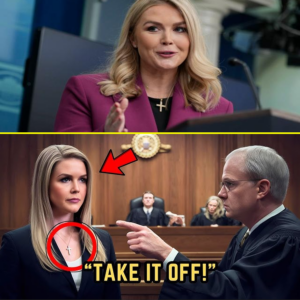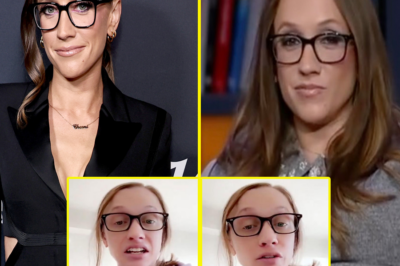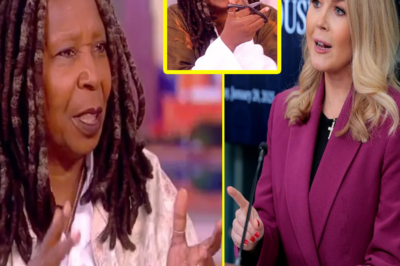A Judge Fined Karoline Leavitt for Wearing a Cross, But Later Discovers Her Legal Acumen—A Case That Raises Questions About Fairness in Courtroom Policies

In a case that has sparked significant public debate, Karoline Leavitt, a rising political figure and advocate, was fined by a judge for wearing a cross during a court appearance. However, the situation took an unexpected turn when the judge later realized Leavitt’s impressive legal knowledge, raising questions about the fairness of courtroom policies regarding religious symbols. The incident has ignited widespread conversations about the treatment of religious expression in public spaces, particularly in legal settings.
Leavitt, who has been vocal about her faith, appeared in court for a routine legal matter. Upon entering, the judge reportedly took issue with her wearing a visible cross around her neck, citing court policies that restrict certain types of attire or religious symbols during proceedings. The judge issued a fine for what was deemed an inappropriate display of religious expression in a setting where neutrality was expected.
However, what followed stunned those involved. Leavitt, well-versed in the law and known for her quick thinking, calmly pointed out that there had been no prior mention of restrictions on religious symbols, especially one as common and significant as a cross. Her knowledge of legal precedent and the First Amendment of the U.S. Constitution, which protects freedom of religion, left the judge reconsidering his stance.
“I was surprised by the fine at first, but I knew I had to stand my ground,” Leavitt later commented. “It’s not just about the cross—it’s about the principle of religious freedom. If we allow people to swear on the Bible in court, why should wearing a cross be treated differently? It’s a symbol of my faith, just like the Bible is a symbol of faith for many others.”
The judge, after hearing Leavitt’s explanation and realizing the potential constitutional implications, withdrew the fine. The moment quickly garnered attention, with many questioning whether the rules that govern the courtroom are truly fair and consistent. If swearing on the Bible—a religious text—is accepted in a court of law, why should a simple religious symbol like a cross be considered a violation?
This incident has prompted a wider conversation about the intersection of religious freedom and the legal system. Many believe the judge’s initial decision was an overreach, as religious symbols have been a part of public life for centuries and are frequently seen in government settings, such as courthouses. For Leavitt, the fine and its subsequent reversal highlighted a double standard that, in her view, needs to be addressed.
“I’m not advocating for a court to be overtly religious,” Leavitt stated. “But we must find a way to balance respect for religious freedom with the idea of neutrality in government spaces. There’s no reason why we can’t have both.”
Legal experts have weighed in, with some suggesting that the case underscores the need for more clarity in court policies regarding religious expression. “This is a gray area that many courts haven’t fully addressed,” said one constitutional lawyer. “The issue at hand isn’t about banning religious symbols, but about creating guidelines that respect both religious freedom and the need for neutrality in a court of law. It’s a delicate balance.”
For many, Leavitt’s handling of the situation demonstrated not only her legal acumen but also her commitment to standing up for her rights. Her calm, reasoned approach to the issue and her ability to navigate the complexities of the law have made her a role model for others facing similar challenges.
As this story continues to unfold, the question of fairness in courtroom policies remains a pressing issue. Should symbols of faith, such as crosses or other religious symbols, be allowed in the courtroom? And if so, where should the line be drawn? For now, Leavitt’s case serves as a reminder of the ongoing struggles for religious expression and the need for clearer guidelines in public spaces.
This article is designed to provoke thought and discussion, highlighting the conflict between religious freedom and court policies. It encourages readers to reflect on the fairness of current regulations and the implications for religious expression in public life













